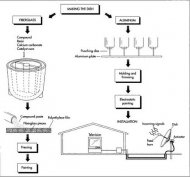Satellite dish materials

Background
A satellite dish is a parabolic television antenna that receives signals from communication satellites in orbit around the earth. Its sole function is to provide the television viewer with a wider variety of channels.
The first communications satellite— Echo I —was launched by the United States in 1960, transmitting telephone signals. In 1961 Relay began transmitting television signals, and in the same year Syncom established itself as the first geosynchronous satellite capable of transmitting signals to one particular section of the earth's surface continuously.
The rapid advances in communication satellite technology were not simultaneously matched by advances in satellite dish use and technology. Television broadcasting began with individual stations that could only serve a limited area. Television networks had to provide their affiliate stations with recordings of programs if they wished to provide nationwide service. Satellite television was not widely available until the 1970s, when cable television stations equipped with satellite dishes received signals that were then sent to subscribers by coaxial cable. By 1976, there were 130 satellite dishes owned by cable companies, and by 1980, every cable television station had at least one satellite dish.
About that time personal satellite dish earth stations were selling for approximately $35, 000 per unit. Taylor Howard, an employee at Stanford University who was well-versed in the usefulness of satellites as relayers of data, is credited with designing the first satellite dish for personal use. Howard's dish, which was placed into operation on September 14, 1976, was made of aluminum mesh and was about 16 feet (5 meters) wide. By 1980, 5, 000 satellite dishes had been purchased for home use. In 1984 alone 500, 000 were installed. Recent reports state that there are 3.7 million owners of home satellite dishes worldwide, and the number will continue to grow.
A typical commercial satellite dish of the 1970s was made of heavy fiberglass, and the dish itself, at its smallest size, had a diameter of about ten feet (three meters). Since then, satellite dish design has shifted toward light-weight, aluminum mesh dishes (similar to Howard's homemade dish), some of which are inexpensive and small (three feet, or one meter, in diameter is typical), with many sections (petals) that can be easily assembled. England, Japan, and Germany, have led the way with direct broadcast TV, which sends signals directly to the viewer's dish, but the United States has yet to do so. This trend would yield smaller, more affordable satellite dishes and regulated satellite programming.

|
Hot Shot Heater for Ka/Ku Slimline Satellite Dish CE (Hughes)
|

|
(Black) Satellite Dish Cover - Snow and Ice Protection for Directv and Dish Network CE (Dish Armor, LLC)
|

|
Siskiyou Philadelphia Eagles Satellite Dish Cover - Philadelphia Eagles One Size Sports (Siskiyou Gifts)
|

|
Venture 18" Inch Linear Actuator Super Jack Arm with Saddle Clamp Dish Mover Black Power Jack 36 Volt Satellite Positioner with Limit Reed Sensor BISS (Summit)
|

|
SuperDeck 12-inch Satellite Dish Mounting System Speakers (RSTC Enterprises)
|
Related posts:

 How to make squash How to remote control desktop using lan tricks Tricks for keeping marks off your nose when wearing sunglasses Quickbooks help how to enter tips…
How to make squash How to remote control desktop using lan tricks Tricks for keeping marks off your nose when wearing sunglasses Quickbooks help how to enter tips… As both J.D. Power and Associates and Consumer Reports have noted, satellite enjoys a superior customer service rating among its multichannel competitors. Sustaining…
As both J.D. Power and Associates and Consumer Reports have noted, satellite enjoys a superior customer service rating among its multichannel competitors. Sustaining… What does tin stand for Tips on how to breed better dragons in dragonvale Linus tech tips how to build a pc what does negative mean what is capital murders mean…
What does tin stand for Tips on how to breed better dragons in dragonvale Linus tech tips how to build a pc what does negative mean what is capital murders mean… Simply activate the receiver through an existing DISH account or subscribe to a new Pay-As-You-Go programming package. Pathway X2 can point to either Western or…
Simply activate the receiver through an existing DISH account or subscribe to a new Pay-As-You-Go programming package. Pathway X2 can point to either Western or… A Dish Network digital video recorder (DVR) is controlled by a specialized remote that is provided with it. The Dish Network remote uses a code that allows it to…
A Dish Network digital video recorder (DVR) is controlled by a specialized remote that is provided with it. The Dish Network remote uses a code that allows it to…